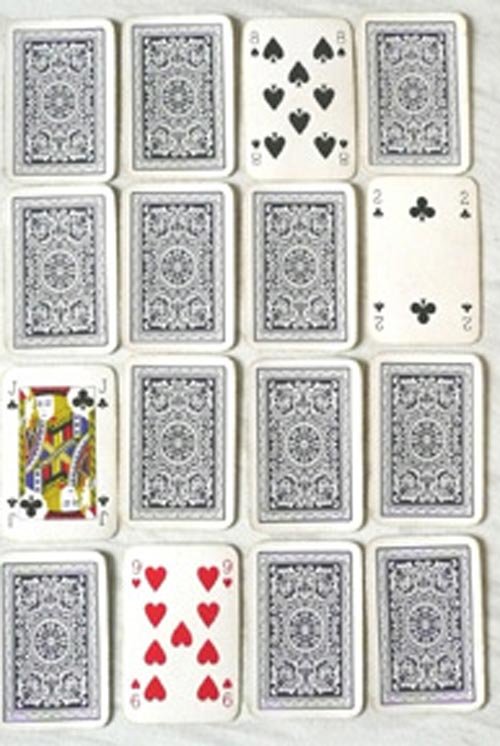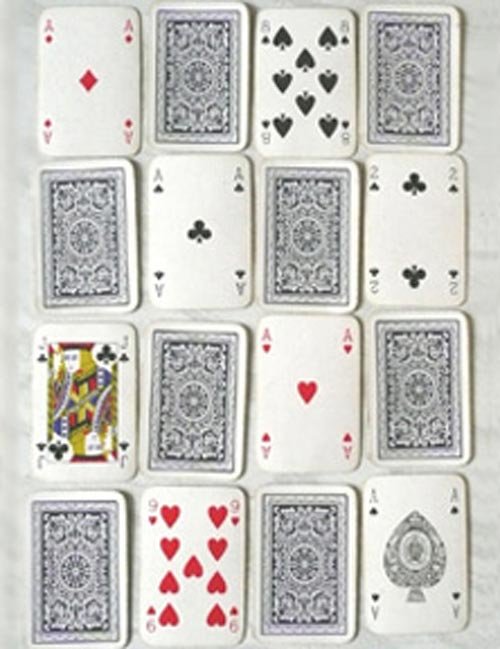1. Card Trick
Take a deck of cards facing up and count off from whatever the first card is until you say “king”.
(for example, if a seven is the top card, you would say 7-8-9-10-J-Q-K).
Take these cards and lay them face down and start over with another stack (In the example above, make certain that the 7 is on top).
Do this until all the cards (52) are used up.
If there are any left (where you could not count to King), hold these in your hand.
Then pick up all but 3 stacks and add those cards to the ones that are in your hand.
Now with the three stacks face down on the table turn the over top card on two of the stacks.
Add the face value of those two cards together. (J=11 Q=12 K=13)
Count off this total from the cards you are holding.
Then count off 10 more.
The total of cards left in your hand is the exact same as the top card on the third stack.
2. Steinmeyer Nine-Card Trick
Jim Steinmeyer is one of the nation’s most creative inventors of magic tricks. A few years ago, he invented a marvellous mathematical trick. Known as the Steinmeyer nine-card trick, it has since been given many clever means of doing it by other magicians. Here is one of the simplest:
Take any nine cards from a standard 52-card deck and deal the nine cards into three piles of cards each. Pick up any pile and remember its bottom card. Drop this pile on top of one of the others, and these six on top of the last pile. The cards remain down throughout.
Hold the nine cards down and spell the value of the chosen card by dealing one card down to the table for each letter. So, if the card chosen is the Queen of Spades, spell Q U E E N and drop the remaining cards on top. Pick up the packet and spell O F. As before, drop the rest of the cards on top. Pick up the packet and spell the suit of the card you selected: S P A D E S. Drop the rest of the packet on top.
The position of the chosen card should now be at a random spot because card names spell out with as few as 10 letters up to as many as 15. So, now spell M A G I C and turn over this last card. Believe it or not, this will always be the selected card!
3. Another Card Trick
Hand your partner an ordinary deck of 52 playing cards. Ask him then to remove, secretly, three cards from the deck, except that no two of the three cards may sum to 10. (So, he may not remove a three and a seven, say.) Tell him that you will now determine the values of these three cards simply by removing cards from the deck quickly, emphasizing that you do so without counting or memorizing any cards.
For purposes of this trick, we consider each card solely according to the face value, with each ace as I and each picture card as 10. Thus, for example, six of clubs is just 6, ten of clubs is just 10, and queen of hearts is just 10.
Have your partner layout the cards, in no particular order, in any convenient fashion, such as a 7×7 array. (The random order is so that the removal of cards won’t make it obvious what was taken.) Now, remove cards in pairs that sum to 10 or 20, such as four of spades and six of diamonds, or ace of clubs and nine of hearts, or ten of hearts and queen of spades.
When you have done this as much as possible, you will be left with either l or 3 cards. Try it now if you don’t believe me! But, you will be able to tell the values of the three cards that were initially removed. Here is how you do it:
If there is one card left, with value x, then x < 10 and two of the picked cards have value 10 and the third has value 10—x. If there are three cards left with values x, y and z each under 10, then the cards chosen have values 10—x, 10—y, 10—z. However, it is possible that one of x, y and z has value 10, say x. In this case, the three card values are 10, 10—y, 10—z. (For instance, if there are three cards left, a ten, a two and a five, then the three cards removed have values 10, 8, and 5.)
4. Equation Magic
Turn your child into a little math-a-magician in no time! This impressive mathematical card trick uses addition and multiplication. Your little one will easily memorize the secrets behind the trick and be able to wow his friends.
What You Need:
Deck of cards
What You Do:
1. Ask your child to shuffle the deck of cards. Tell him that for the purposes of the game aces = 1.
2. Have him look at the bottom card and memorize it.
3. Tell him to place the deck on the centre of the table and turn over the top 3 cards.
4. Now, have him deal cards below each of the 3 cards he turned over. He’ll need to figure out how many cards to place down. To do this, have him subtract the number amount on the face up card from 15. For example: If the card is 5, he should deal 10 cards under it. 15—5 = 10.
5. Now have him collect all cards he dealt in step 4, and put them on the bottom of the deck. The three original face-up cards should remain on the table.
6. Ask him to find the sum of the three face-up cards and deal out that many cards. For example: If the 3 face-up cards are 2, Ace, and 5, he performs this addition operation 2 + 1 + 5 = 8.
7. Then, place those cards on the bottom of the deck.
8. Time for the magic! Explain that you can force any card to come out of the deck whenever you like. Now, ask him to name the card he chose in step 1.
9. Wave your hand over the deck of cards mysteriously. Ask for his card to come forth! Encourage your little one repeat the command with a sly smile.
10. Have him turn over the cards one by one on the top of the deck. At first, he won’t see anything special. However, have him keep turning slowly as you say, “This is the first card, here’s the second, this one’s the third, and the (name of his card), comes fourth!” The fourth card will be his card!
11. How did you do that? Explain to him that each face-up card is equal to the amount of the card subtracted from 15, plus the value of the card = 16. Multiply 16 x 3 and you get 48. And, 48 + 4 = 52. There are 52 cards in a deck!
5. Amazing Cards

Maths isn’t always deadly serious. To prove it, here’s a card trick to amaze your friends in the school or neighbourhood. It was invented by Arthur Benjamin, a mathematician and magician at Harvey Mudd College in California.
Take a pack of cards and deals the top 16 face down in four rows of four. Turn four of these cards face up. Call for a volunteer from the audience, who will repeatedly ‘fold up’ the square of cards, like folding a sheet of stamps along the perforations, until it ends up as a single pile of 16 cards.
The audience will decide where the folds occur. For instance, the first fold can be along any of the three horizontal lines between the cards, or the three vertical lines.
When the cards have been folded into one pile, the volunteer spreads them out on the table. Either 12 cards are face down and 4 face up, or 4 cards are face down and 12 face up. In the first case, the face-up cards miraculously turn out to be the four aces. In the second case, the volunteer takes the four face-down cards, and turns them over to reveal… the four aces.
Magic!

To prepare the pack, the magician arranges the four aces in positions 1, 6, 11 and 16 from the top down. After dealing out the four rows of cards, the aces lie along the diagonal from top left to bottom right. But they’re face down, so the audience doesn’t see that. He also has to turn over the right four cards, to make the square look like this:
The trick then works automatically, no matter which sequence of folds the audience chooses. Magic again!
Why does the trick work?
Imagine turning the cards along the diagonal the other way up. Then the square has a pattern like a chessboard, and the aces run along the diagonal:

However, you fold the square the cards that end up in a given position will all face the same way: either all up or all down. For instance, suppose you fold along the central vertical line, and think of the top row. The third card (up) turns over (down) and is placed on top of the second card—also down. And the fourth card (down) turns over (up), and is placed on top of the first card—also up.
Now you have a rectangle, made from cards or small piles of cards, and it has the same chessboard pattern of ups and downs. So the same thing happens for the next fold, and the next… By the time you reach a single pile, all of the cards in the pile face the same way.
However, when you started, the cards on the diagonal were the wrong way up compared to the chessboard pattern. After folding, they will again be the wrong way up. So instead of a pile of 16 cards all facing the same way, you will have a pile with 12 cards facing one way, and the four aces facing the other.
Mathematically, the chessboard pattern has ‘colour symmetry’. The fold lines act like mirrors, and the mirror-image of each card sits on top of a card that faces the other way. This idea is used to study how the atoms in crystals are arranged. The cunning bit is to turn the maths into an effective card trick.

